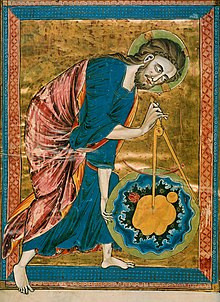Quadrivium
From the time of Plato through the Middle Ages, the quadrivium (plural: quadrivia[2]) was a grouping of four subjects or arts—arithmetic, geometry, music, and astronomy—that formed a second curricular stage following preparatory work in the trivium, consisting of grammar, logic, and rhetoric.
The quadrivium, Latin for 'four ways',[4] and its use for the four subjects have been attributed to Boethius, who was apparently the first to use the term[5] when affirming that the height of philosophy can be attained only following "a sort of fourfold path" (quodam quasi quadruvio).
[citation needed] These four studies compose the secondary part of the curriculum outlined by Plato in The Republic and are described in the seventh book of that work (in the order Arithmetic, Geometry, Astronomy, Music).
The study was eclectic, approaching the philosophical objectives sought by considering it from each aspect of the quadrivium within the general structure demonstrated by Proclus (AD 412–485), namely arithmetic and music on the one hand[14] and geometry and cosmology on the other.
Morris Kline classified the four elements of the quadrivium as pure (arithmetic), stationary (geometry), moving (astronomy), and applied (music) number.


